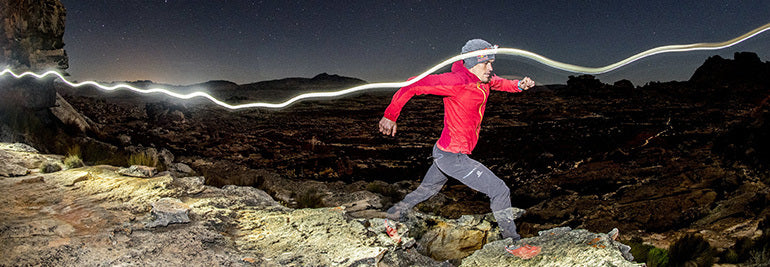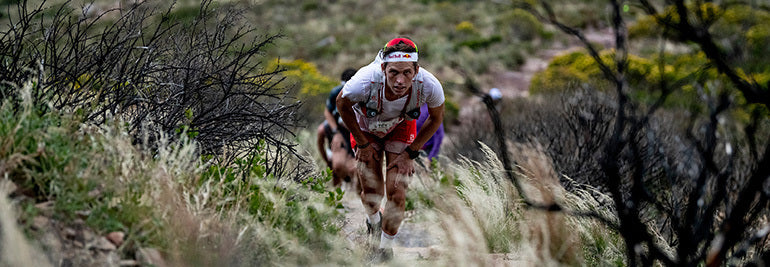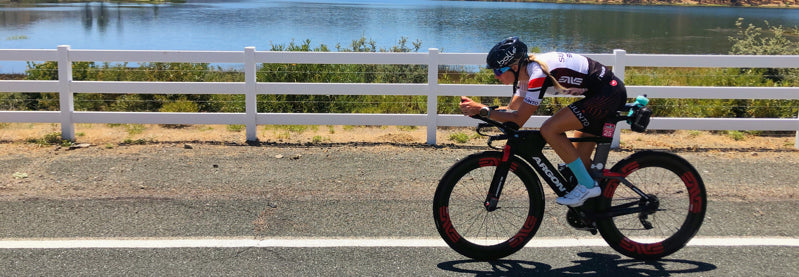

Suunto Blog

7 tips for running in the dark
© Dean Leslie / Red Bull Content Pool
As the northern hemisphere heads into winter, Ryan Sandes’s hometown, Cape Town, is coming out of it. He recently ran his new 13 Peaks route, starting at 3am, and had an eerie feeling that someone was watching him. “I looked around and there were all these little eyes looking at me from out of the darkness,” he says. “They were rock rabbits.”
Ryan has run in the dark in some gnarly places. He says it’s completely different to running in the day. “Running in the dark is a bit like running downhill – you have to be careful,” he cautions. Here are 7 tips to better enjoy running at night or early morning.
Stay safe
Tell someone where you are going and when you plan to be back. This is especially important if you are heading out for a trail run in the wild. Consider taking a tracking device, too. If you get disoriented or lost, remember you can use the Find Back feature and breadcrumb route on your Suunto 9 watch to be led back to your start point.
Make yourself visible
Buy yourself an assortment of reflectors for your clothing so you are clearly visible to cyclists and drivers from a distance. Use “biological motion” for increased visibility; this means lighting up your joints – ankles, knees, wrists and elbows, not the torso – so motorists and cyclists recognise you as a moving person.
Slow down
If you’re new to running in the dark, Ryan suggests slowing down until you get used to it. “The more you practice, the better you’ll get,” he says.
Master your headlamp
Wearing a headlamp is essential if you’re running in an area with no streetlights. Learning to focus and point the beam correctly takes some fiddling; best to test this at home before heading out. Aim the lamp so the beam illuminates the area about 10 m or so out from you, and make sure the light isn’t too focused or it can give you “tunnel vision”.
Learn to adjust the settings while you’re running to preserve battery life. “If you’re going downhill really fast you will need to have it brighter and with a bigger beam,” Ryan says. “If you are going uphill slowly you can turn it down.”
Look ahead, not down
Having the right head position is important. “Don’t drop your head and start looking at your feet because that automatically slows you down,” Ryan says. “Look ahead, and your brain will programme where your feet will go before they get there.”
Pick your lines
With the correct head position and beam focus, it makes it easier to see the contours of the terrain and coming obstacles. Staying focused, not spacing out, is essential when running in the dark. “Try to pick right lines [to follow] when you’re running so you can keep moving,” Ryan says. “You don’t want to lose concentration and end up going over a bunch of rocks, or scrambling through the bush.”
Enjoy the atmosphere
“Running in the dark gives an almost out of body experience,” Ryan says. “Everything is really peaceful, you can hear all the little sounds, everything seems fresher, and you become a lot more aware. Enjoy it!”
Lead images:
© Craig Kolesky / Red Bull Content Pool
© Graeme Murray / Red Bull Content Pool
Read more running related articles!
7 principles to help you find the flow
The lazy runner's guide to a marathon
Emelie Forsberg's 7 yoga poses for runners
7 tips for running in hot weather

Hunter or the hunted? 7 race tactics for the trophy
Both of them know the feeling of being hunted. It’s when they’ve been in first place, and there’s a pack of wolves at their heels.
“When you are leading a race you often feel like a hunted animal,” Ryan says. “You are always looking behind you, are you going too fast, are you going slow enough, are the guys catching you? Mentally, that is super draining. Sometimes hunting is better than being hunted.”
Ryan, an ultra running champion, has felt invincible during some races, and that his competitors were “dead and buried”, only for them to suddenly catch up and pass him. Mel has literally run shoulder to shoulder against another triathlete for 15 km, in what she says “felt like an eternity”. In the last three kilometers she turned it on and left her rival in the dust.
“I started sprinting and not looking back,” Mel says. “It turns out she didn’t even try to come with me, but I didn’t turn around to check. I just kept pushing right to the line.
“The smarter and easier move would have been to sit in (behind) and wear my competitor down that way, but for some reason we both thought we needed the mental battle of running side by side for most of the run. Not a single word was spoken between us during this hour long battle. After the race, we both shared a laugh and commented on how much we made each other suffer out there. “
Here are Mel and Ryan’s seven tips for victory.
© Kelvin Trautman / Red Bull Content Pool
Keep a poker face
Both of them recommend putting on a brave face. Show your rivals nothing. “Control your breathing and keep good form at least when they can see you,” Mel says. “Make it look easy. Don’t make eye contact with your rivals.”
Stay to your strengths
Don’t try to run your rival’s race. “The key strategy is to run to your strength,” Ryan says. “If you're slightly better on the climbs, push them a little bit, so then your competitor has to push the downhills to catch up, smashing his legs in the process. It's all about trying to feel your competitor out, seeing what their weaknesses are, compared to your strengths.”
Remember, they hurt too
Feeling the pain? Quads burning? That’s because you’re human, and your rivals are, too. “I know if I’m hurting so are my competitors so I stay focused and imagine them struggling and working hard,” Mel says. “That gives me a little confidence boost.”
Mind game your rival
Watch your rival closely. If he or she is struggling, accelerate. “When you think they’re feeling bad, start talking to him or her with your poker face on, pretending you’re feeling good,” Ryan suggests. “It’s a bit of a game of roulette; sometimes it pays off, other times it doesn’t.”
Training is your dojo
Training is when you test your mettle. It’s when you develop the tenacity and forbearance you’ll need to survive your race battles. “Never give up in training,” Mel says. “When I’m really hurting in training, I imagine I’m in a race situation and that if I back off now or give up, I’ve just lost the race. The more times you throw in the towel in training the harder it will be to push through the pain in a race.”
Ryan recommends working on your weaknesses in training. “If descending isn’t a strength for you, work on it,” he says. And when you’re training, run at different intensities.”
Learn to adapt
While it’s necessary to have a race plan, remember whatever your plan is, no matter how slick it is, on race day it will probably go out the window. “It’s so important to keep your mental focus and stay calm and collected,” Ryan says. “The person who is the most successful in a race is the one who can think the best on his or her feet and go with the flow.”
Kindness can pay off
Yes, racing is about winning. But that doesn’t always demand a ruthless attempt to crush the opposition. Sometimes a little camaraderie and kindness can go a long way. “If a competitor is struggling, for example when they need nutrition or a cold sponge, if I have the energy to help out I will because this not only helps them, but it also helps me,” Mel explains. “Helping someone makes you feel good and when you feel good you race better. This is a great way to get a little lift.”
Lead images:
© Craig Kolesky / Red Bull Content Pool
© Kelvin Trautman / Red Bull Content Pool
Read more:
The art of battle: six tactics to slay your competitors

One triathlete’s journey through hell and back to the Kona start line
Doctors told her she would never run or race again. Kelsey, then 31, was lying in a hospital bed, her body battered and bruised after a truck hit her, and her vision for her life in ruins. She decided to prove the doctors wrong.
After recovering from the accident Kelsey drove herself hard. She refused to give up. While the determination was admirable, she now admits it bordered on reckless.
“I spent the next year trying to come back, but was plagued with more injuries and frustration,” Kelsey explains. “I gained a lot of weight and fell into a depression where I coped by going out at night, drinking way too much, and just not really living life as a pro athlete.”
Kelsey began swimming competitively when she was six years old. Later at college, she competed in Division 1 before moving to the Olympic Training Center in Colorado Springs as a member of the USA Triathlon National Team. She completed her first triathlon as a senior high school student in 2001, and was hooked.
With her life in tailspin after the accident, Kelsey got close to quitting triathlon. But then she met Mike, her now coach and boyfriend, who helped her turn everything around.
“The new path I chose to go down was life changing, but not easy,” she says. “Mike got me healthy for the first time years. But when I did decide to start racing again, I was in for a rude awakening. I moved up from ITU (International Triathlon Union races) to the 70.3 distance and finished dead last in most of those races.”
She was going in the right direction. But some old bad habits were holding her back. Eventually Mike gave her an ultimatum: get a job and make triathlon a hobby or commit 100% and make triathlon her job. “It took a good week for me to decide to go ‘all in’, but when I did, everything switched for me,” she says.
The decision empowered her; in 2017 she won her first Ironman 70.3 at Victoria, then backed that up with a win at Ironman 70.3 Manta the following weekend. She has been on the podium at almost every race since, securing her first Kona slot this year at age 36.
“This just goes to show you that if you work really hard and don’t give up, amazing things can happen!” she says.
Kelsey takes over our our Instagram stories this weekend. Follow along as she prepares for Kona!
READ ALSO
How (not) to qualify for Kona
Road to Kona: Cody Beals' clear race strategy
Road to Kona: 5 tips to train effectively as a couple

Fuelling the engine: 6 principles of nutrition for athletes
When she's not in the mountains, you can find Emelie Forsberg in her garden or preparing delicious meals. © Matti Bernitz
How and what we eat is personal to each one of us. Some of us feel better and more energised by certain foods, while others feel quite differently. Regardless of our personal view, one thing we all have in common is that eating well is essential for top performance.
In our recent article series “Fuelling the engine” we heard from eight athletes and trainers about how they stay fuelled (see the end for the article list). What’s more interesting than their differences, is what they have in common. We’ve combed through and put together six basic principles of nutrition for athletes.
Find your rhythm
Suunto HQ is lucky to have in-house personal trainer and athlete Matias Anthoni walking around the office. He offers training and nutrition advice to whoever is interested. He says improving how often you eat can improve what you eat. Skipping meals is a no-no for dedicated athletes because it causes energy crashes and bad dietary decisions, which result in poor performance. He advises to get into a rhythm of having a healthy meal every three hours.
Get organized
To eat six or more well balanced meals a day demands forward planning. It’s pretty hard, if not impossible, to maintain this if you’re operating on a day-to-day basis. Ryan Sandes, Emelie Forsberg, Mel Hauschildt and Lucy Bartholomew all emphasised the importance of being well organised and planning ahead. They sometimes make extra portions of meals at the beginning of the week to have later in the week when they know they will be busy. Being organised means making sure there are plenty of easy, go-to meal ingredients available, too.
Balanced meals
There are a number of different aspects to having a balanced diet. Ultracycling man Omar di Felice sees it as maintaining a proper balance of carbohydrates, protein and fat, with fatty food being essential for his epic extreme rides above the Arctic Circle every winter. This balance of carbohydrates, protein and fat is what nutrition expert Dr. Rick Kattouf II also drills into his clients. He believes every meal – for dedicated athletes in training – should include this ratio: 50 to 60 % carbohydrates, 15 to 25 % protein, and 15 to 25 % fat. Balance also means eating a variety of foods to make sure you are taking in enough minerals and vitamins. Ski mountaineer Greg Hill tries to have a balance of colors in his meals.
Fresh is best
One thing that came through loud and clear from all our athletes and experts is the importance of eating fresh foods. For Emelie Forsberg and Lucy Bartholomew this means preferably straight out of the earth. As an avid gardener and farmer, Emelie grows and harvests much of what she eats. Lucy, ski mountaineer Greg Hill, Mel and Ryan all try to avoid eating packaged foods, instead choosing foods that are as close to the source of production as possible.
Whole is the goal
Should go without saying: avoid processed food and food with refined sugar. Instead, all our athletes opt for whole foods. Ryan Sandes questioned the idea that recovery shakes could ever replace the nutritional value of whole food. Don't take shortcuts; take the time to eat well. It’s self kindness.
Enjoy yourself
Emelie, Ryan and Greg all said they don’t get uptight about food. Emelie has a relaxed and intuitive approach to food, and Ryan and Greg are happy to allow themselves to enjoy a pizza or a burger each week. Greg cautions not to try to be perfect; aim to make the bulk of what you eat fresh and healthy. “It’s important to enjoy life as well,” Ryan says.
Click below to read articles in our Fuelling the Engine series:
Fuelling the engine: talking nutrition with Lucy Bartholomew
Fuelling the engine: talking nutrition with Emelie Forsberg
Fuelling the engine: a commonsense approach to nutrition
Fuelling the engine: talking nutrition with Ryan Sandes
Fuelling the engine: talking nutrition with Ultracycling Man
Fuelling the engine: talking nutrition with Mel Hauschildt
D.I.E.T (disaster imminent every time), and three unchanging principles of nutrition for athletes
Fuelling the engine: talking nutrition with Greg Hill
Lead images:
Photo by ja ma on Unsplash
© Craig Kolesky / Red Bull Content Pool

New life through running
Needless to say, Liz is no stranger to hard work and dedication. After pacing a friend during an ultramarathon, she decided it was something she would like to try. She has since embraced the sport of ultrarunning, and since 2015 has powered through three 100-mile ultramarathons. Her short time in ultrarunning has already changed her life and taught her lifelong lessons.
“I'm realizing that the most I learn after each long-distance race is how to be a kinder and more flexible person. I bring too much of my Type A personality to these events and have to keep improving my ability to compromise, goal-set on the fly, and most of all, smile,” says Liz.
Watch the video below to see how running has changed Liz’s life.

Fuelling the engine: talking nutrition with Greg Hill
Record-breaking ski mountaineer, adventurer and Suunto ambassador Greg Hill has always been a foodie. Eating well is about enjoyment, which also serves his nutritional needs. He approaches it in that order, not vice versa.
“Nutrition has always been important but more so because I really enjoy eating great food,” he explains. “Yet I also understand that the fuel we put in our bodies determines how well it runs. Much like an engine, if you put bad gas into it, it will run poorly.”
Photo by Angela Percival/ Arcteryx
Fresh colors
Greg tries to eat fresh vegetables with a variety of colors, which he says indicates nutritional richness. Whenever possible, he also cooks with food from local sources. “I do grow a small garden every year, with tomatoes, potatoes, garlic, carrots, broccoli, beets, just your basics,” he says. “It’s so nice to go and grab them directly from my yard.”
Week day diet
Greg and his family are following the “week day vegetarian diet”, meaning they only meat on the weekends. This contributes to personal health and reduces their impact on the planet. “The personal health side is pretty clear, there are so many articles about reducing red meat in your diet and the benefits involved, from a reduced potential for cancer to lower cholesterol, to living longer,” he says.
“One of the simplest way to decrease my family’s carbon footprint was to decrease our meat intake; livestock farming is responsible for 20-50 per cent of the greenhouse gases, so this was an easy way to become better earth dwellers. If you ever look into livestock it is amazing the deforestation involved, the extreme water usage and over un-sustainability of it.
Photo by Angela Percival/ Arcteryx
Healthy balance
While the Hills like to keep it fresh, they also allow themselves to indulge in a fast food meal once a week, like ordering a pizza on Friday movie night. Perfection is not the goal, Greg says, just as long as the the bulk of their diet is fresh, healthy food.
“Like every family we have certain meals that are staples, enchiladas, lasagna, salad rolls, pad thai, pizza on friday nights, and my favourite – the glory bowl,” he says.
Tofu glory bowl
In the bowl
2 cups cooked brown rice1/2 cup grated beetroot1/2 cup grated carrots1/2 cups almonds, toasted1/2 cups spinach leaves1 cup tofu, cubed
Dressing
1/4 cup tahini1/4 cup apple cider vinegar1/2 cup nutritional yeast flakes2 gloves garlic3 tablespoons tamari1 tablespoon maple syrup1/4 cup olive oil1/4 cup water
Instructions
Prepare the brown rice and set aside.Fry tofu cubes in a pan.Add dressing ingredients into a blender to prepare the dressing. Add oil in a steady stream. Taste, and thin with water if required.Assemble the bowls by placing cooked brown rice into two bowls, top with beets, carrots, spinach leaves, almonds and fried tofu cubes.Drizzle bowls with dressing.
Lead image: Photo by Fancycrave on Unsplash.
Click below to read articles in our Fuelling the Engine series:
Fuelling the engine: talking nutrition with Lucy Bartholomew
Fuelling the engine: talking nutrition with Emelie Forsberg
Fuelling the engine: a commonsense approach to nutrition
Fuelling the engine: talking nutrition with Ryan Sandes
Fuelling the engine: talking nutrition with Ultracycling Man
Fuelling the engine: talking nutrition with Mel Hauschildt
D.I.E.T (disaster imminent every time), and three unchanging principles of nutrition for athletes














































































